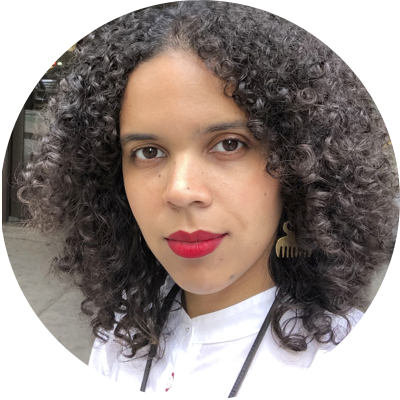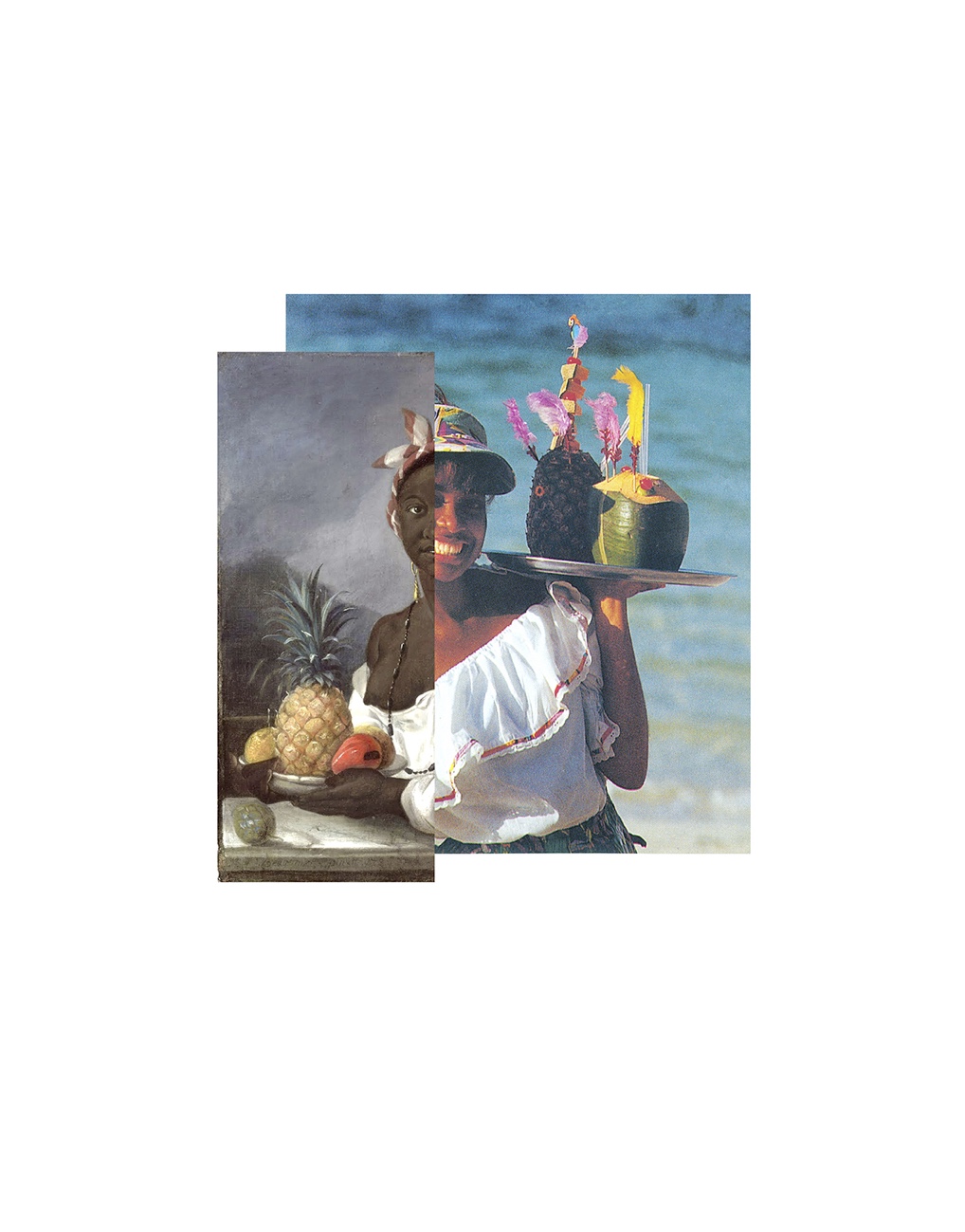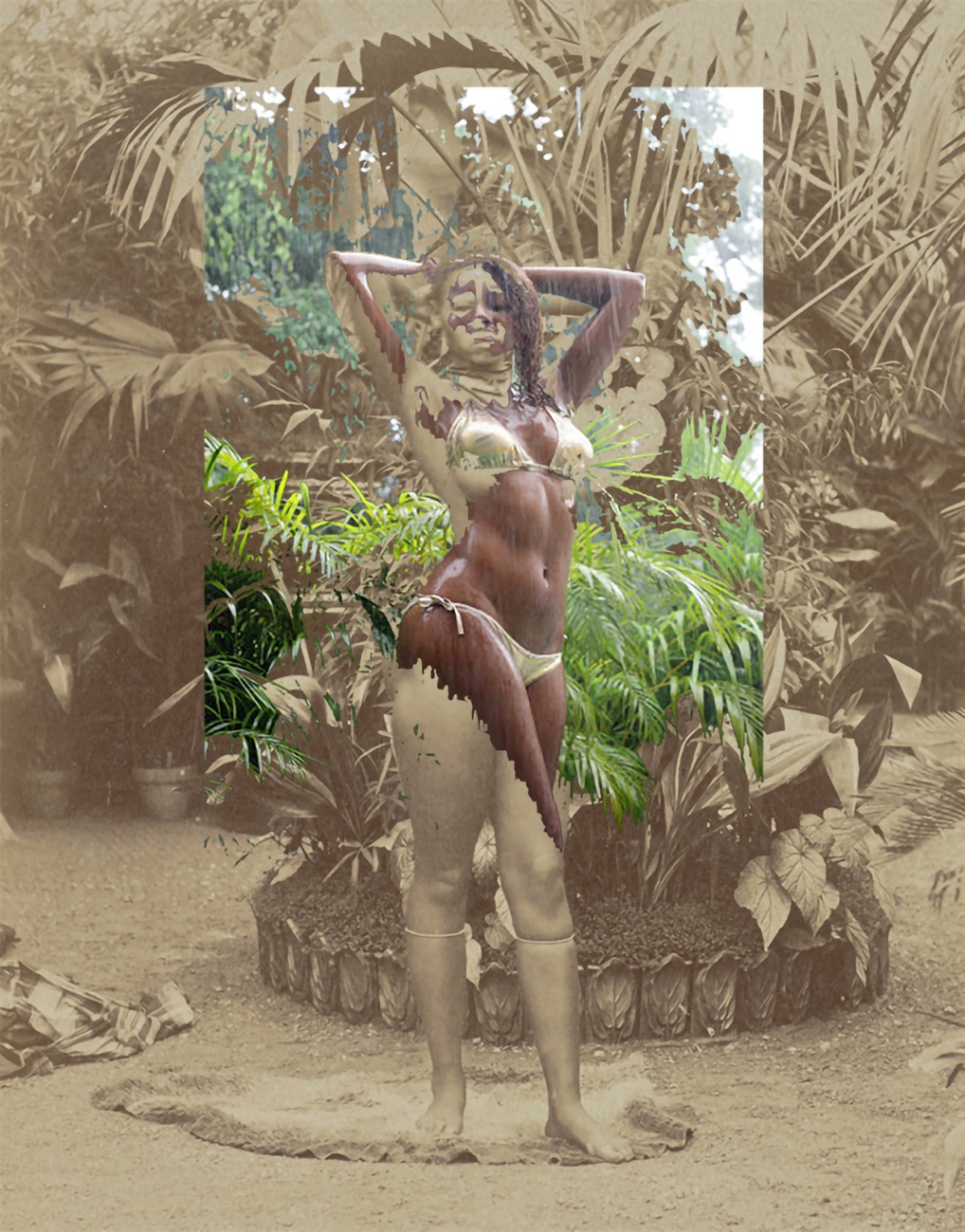Joiri Minaya
Continuum I (2020) / Continuum II (2021)
This series of collages mixes imagery that depict women and nature in the Caribbean and other tropical spaces, like Google search results, Caribbean postcards and touristic brochures, ethnographic photography, art history paintings and other sources. I’m interested in the gestures and performativity of the women depicted, how the images present the subject as “available,” and by extension, the Caribbean landscape, and how these characteristics extend throughout the different visual traditions I pull from in spite of the diverse mediums, formats, location and temporalities they come from. While the collages point to the circularity of the Gaze that produces these images, they also meditate on inhabiting pre-imagined roles as a way to sabotage them.
The background image in Continuum I was taken by Roland Bonaparte, who photographed a number of people brought to Europe and the US to be studied by anthropologists and be exhibited in zoological gardens as specimens in reconstructed native villages during the Exposition Universelle of 1889 in Paris. The fragments of the image on top of it is an image that came up in the results of the Google search for “Dominican women”. I was interested in the continuity of the pose, and the action of posing for somebody in this manner, which is somewhat unnatural and performative, trying to map this performativity through a visual genealogy of sorts. I’m also interested in how both images are framed by nature, which in both cases is artificially constructed, meaning, the plants are real but the space is constructed and maintained to emulate certain ideas of tropicality and exoticism. “The photograph validates the existence of a type, even if that type is entirely constructed by the photographer.” (Deborah Willis and Carla Williams, The Black Female Body in Photographs from World’s Fairs and Expositions, published in Exposure, Volume 33½. Williams and Willis discuss the images Bonaparte took in their year 2000 essay).
In Continuum II similar conversation is happening, but with two images that are sourced closer to the island shared between the Dominican Republic and Haiti, where the artist is from. The image to the left is a fraction of a well-known painting by Canadian artist Francois Beaucourt recently retitled “Portrait of a Haitian Woman” and formerly known as “Portrait of a Negro Slave” (1786). The image to the right is a section of an image of a touristic brochure of Bávaro, a touristic town in the far East of the Dominican Republic. The collage underscores the shared idea of servitude between the two very different contexts of slavery and tourism, and the parallels in the way both women are available to the maker of the image: holding fruits, with a smile. “The sexually charged nature of Portrait of a Haitian Woman— the deliberate juxtaposition of the breast with the tropical fruit — is indicative of the precarious status of Black female slaves and their vulnerability to sexual exploitation.” writes Charmain A. Nelson in an article about this painting for the Canadian Encyclopedia website. Much can be also said about the sexualization, vulnerability and exploitation of women who work on the touristic industry in the Dominican Republic, as well as the places in the Caribbean. Minaya has also explored relations between fruits and the body of black and brown women in tropical spaces in works like Mango Slice (The King’s Wife) in 2018 / 2020.
Esta serie de collages mezcla imágenes que representan mujeres y la naturaleza en el Caribe y en otros espacios tropicales, como resultados de búsqueda de Google, postales caribeñas y folletos turísticos, fotografía etnográfica, pinturas de historia del arte y otras fuentes. Me interesan los gestos y la performatividad de las mujeres representadas, cómo las imágenes presentan al sujeto como “disponible” y, por extensión, el paisaje caribeño, y cómo estas características se extienden por las diferentes tradiciones visuales que utilizo a pesar de la diversidad de medios, formatos, ubicación y temporalidades de donde proceden. Si bien los collages apuntan a la circularidad de la mirada que produce estas imágenes, también tratan de habitar los roles pre-imaginados como una forma de sabotearlos. La imagen de fondo en Continuum I fue tomada por Roland Bonaparte, quien fotografió a varias personas traídas a Europa y Estados Unidos para ser estudiadas por antropólogos y exhibidas en jardines zoológicos como especímenes en pueblos nativos reconstruidos durante la Exposición Universal de 1889 en París. Los fragmentos de la imagen en la parte superior son de una imagen que apareció en los resultados de la búsqueda en Google de “mujeres dominicanas”. Me interesó la continuidad de la pose y la acción de posar para alguien de esta manera algo antinatural y performativa, tratando de trazar un mapa de esta performatividad a través de una especie de genealogía visual. También me interesa cómo ambas imágenes están enmarcadas por la naturaleza, que en ambos casos está construida artificialmente, es decir, las plantas son reales pero el espacio está construido y mantenido para emular ciertas ideas de tropicalidad y exotismo. “La fotografía valida la existencia de un tipo, incluso si ese tipo es construido en su totalidad por el fotógrafo” (Deborah Willis y Carla Williams, The Black Female Body in Photographs from World’s Fairs and Expositions, publicado en Exposure, Volumen 33½. Williams y Willis discuten las imágenes que Bonaparte tomó en su ensayo del año 2000). En Continuum II se está produciendo una conversación similar, pero con dos imágenes más cercanas a la isla compartida entre República Dominicana y Haití, de donde es la artista. La imagen de la izquierda es una fracción de una pintura muy conocida del artista canadiense Francois Beaucourt recientemente titulada “Retrato de una mujer haitiana” y anteriormente conocida como “Retrato de un esclavo negro” (1786). La imagen de la derecha es una sección de una imagen de un folleto turístico de Bávaro, una ciudad turística en el extremo oriente de la República Dominicana. El collage subraya la idea compartida de servidumbre entre los dos contextos muy diferentes de la esclavitud y el turismo, y los paralelismos en la forma en que ambas mujeres están disponibles para el creador de la imagen: presentando frutas y sonriendo. “La naturaleza cargada de sexualidad del ‘Retrato de una mujer haitiana,’ la yuxtaposición deliberada del pecho con la fruta tropical, es indicativa del estado precario de las esclavas negras y su vulnerabilidad a la explotación sexual,” escribe Charmain A. Nelson en un artículo sobre esta pintura para el sitio web Canadian Encyclopedia. Mucho se puede decir también sobre la sexualización, vulnerabilidad y explotación de las mujeres que trabajan en la industria turística en República Dominicana, así como en distintos lugares del Caribe. Minaya también ha explorado las relaciones entre las frutas y el cuerpo de mujeres negras y morenas en espacios tropicales en obras como Mango Slice (La esposa del rey) en 2018/2020.

ARTIST:
Joiri Minaya
Santo Domingo, Dominican Republic / New York, US
Joiri Minaya (1990) is a NY-based Dominican-United Statesian multi-disciplinary artist. She studied art at the ENAV (DR), the Chavón School of Design, and Parsons. Minaya has exhibited across the Caribbean, the U.S. and internationally. She recently received a Jerome Hill Fellowship, a NY Artadia award and the BRIC’s Colene Brown Art Prize, and has participated in residencies at Skowhegan, Smack Mellon, Bronx Museum, Red Bull House of Art, LES Printshop, Socrates Sculpture Park, Art Omi, ISCP and Vermont Studio Center.
My ideas are concerned with otherness, self-consciousness and displacement.
I’ve made work inspired by women in my family, labor, dislocation, psychology, myth, art history, magic realism and symbols. I’m interested in how historical hierarchies inform and condition current identities; how constructions manifest through the body: how they are received, internalized and then regurgitated by it.
Living between the United States and the Dominican Republic (and having lived in Belgium) has made me aware of my own difference and subjectivity depending on context. Reflecting on this, my work has transitioned from identity in an intimate manner to examining larger transnational and transcultural exchanges.
My current body of work focuses on the construction of the female subject in relation to nature and landscape in a “tropical” context, shaped by a foreign Gaze that demands leisure and pleasure. Like nature, femininity has been imagined and represented throughout history as idealized, tamed, conquered / colonized and exoticized. I’m currently revising existing cultural products that engage in this form of representation and challenging them through my work.
My process is an on-going exploration across media: a painting or a sculpture might be a departing point for a video or a performance, and they might all merge into a final piece or develop independently. The constant in my work is the presence of the body and the interest in creating distinct power positions with it, often contradictory but operating simultaneously. To navigate binaries in search of inbetweenness, trying to both fulfill and sabotage expectations at once.”
Joiri Minaya (1990) es una artista multidisciplinaria dominicano-estadounidense radicada en Nueva York. Estudió arte en la ENAV (DR), en la Escuela de Diseño Chavón y en Parsons. Minaya ha exhibido en el Caribe, Estados Unidos e internacionalmente. Recientemente recibió una beca Jerome Hill, un premio NY Artadia y el premio Colene Brown Art Prize del BRIC, y ha participado en residencias en Skowhegan, Smack Mellon, Bronx Museum, Red Bull House of Art, LES Printshop, Socrates Sculpture Park, Art Omi, ISCP y Vermont Studio Center.
“Mis ideas se refieren a la alteridad, a la autoconciencia y al desplazamiento.
He realizado trabajos inspirados en mujeres de mi familia, trabajo, dislocación, psicología, mitos, historia del arte, realismo mágico y símbolos. Me interesa cómo las jerarquías históricas informan y condicionan las identidades actuales; cómo se manifiestan las construcciones a través del cuerpo: cómo son recibidas, internalizadas y luego regurgitadas por él.
Vivir entre Estados Unidos y República Dominicana (y haber vivido en Bélgica) me ha hecho consciente de mi propia diferencia y subjetividad a partir del contexto en que habito. Reflexionando sobre esto, mi trabajo ha pasado de la identidad de una manera íntima a examinar intercambios transnacionales y transculturales más amplios.
Mi trabajo actual se centra en la construcción del sujeto femenino en relación con la naturaleza y el paisaje en un contexto “tropical”, moldeado por una Mirada ajena que demanda ocio y placer. Como la naturaleza, la feminidad ha sido imaginada y representada a lo largo de la historia como idealizada, domesticada, conquistada / colonizada y exotizada. Actualmente estoy revisando los productos culturales existentes que participan en esta forma de representación y desafiándolos a través de mi trabajo.
Mi proceso es una exploración continua a través de los medios: una pintura o una escultura puede ser un punto de partida para un video o una actuación, y todos pueden fusionarse en una pieza final o desarrollarse de forma independiente. La constante en mi trabajo es la presencia del cuerpo y el interés por crear con él distintas posiciones de poder, muchas veces contradictorias pero operando simultáneamente. Navegar por binarios en busca de entremedios, tratando de cumplir y sabotear las expectativas a la vez.”
Awilda Sterling | San Juan, Puerto Rico
Tercera raíz (Third Root)
Carlos Martiel | Havana, Cuba
Oficios de piel curtida
Fabio Melecio Palacios | Palmira, Valle del Cauca, Colombia
Continuum I, Continuum II
Joiri Minaya | Santo Domingo, Dominican Republic / New York, US
The Little Match Girl / The Emperor's New Clothes
La Vaughn Belle | Christiansted, US Virgin Islands
Preparasyon ke mankai fiwa ba la guerra
Las Nietas de Nonó | Carolina, Puerto Rico
In search of lost suns
Leasho Johnson | Kingston, Jamaica
But the real ones, just like you, just like me
Luis Vasquez La Roche | Venezuela / Trinidad
Cuerpo pátina – Cuerpo athanor: Legado de la esclavitud en cuerpos racializados
PERMANENCIAS | Cartagena, Colombia



